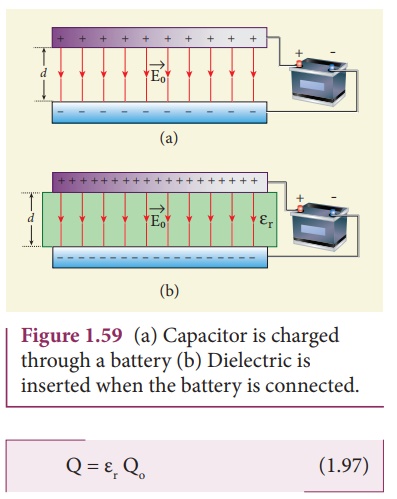Chapter: 12th Physics : Electrostatics
Effect of dielectrics in capacitors
Effect of dielectrics in capacitors
In earlier discussions,
we assumed that the space between the parallel plates of a capacitor is either
empty or filled with air. Suppose dielectrics like mica, glass or paper are
introduced between the plates, then the capacitance of the capacitor is
altered. The dielectric can be inserted into the plates in two different ways.
(i) when the capacitor is disconnected from the battery. (ii) when the
capacitor is connected to the battery.
(i) when the capacitor is disconnected from the battery
Consider a capacitor
with two parallel plates each of cross-sectional area A and are separated by a
distance d. The capacitor is charged by a battery of voltage V0 and
the charge stored is Q0. The capacitance of the capacitor without
the dielectric is

The battery is then
disconnected from the capacitor and the dielectric is inserted between the
plates. This is shown in Figure 1.58.

The introduction of
dielectric between the plates will decrease the electric field. Experimentally
it is found that the modified electric field is given by

Here Eo is
the electric field inside the capacitors when there is no dielectric and εr
is the relative permeability of the dielectric or simply known as the
dielectric constant. Since εr > 1, the electric field E < Eo.
As a result, the
electrostatic potential difference between the plates (V = Ed) is also reduced.
But at the same time, the charge Qo will remain constant once the
battery is disconnected.
Hence the new potential
difference is

We know that capacitance
is inversely proportional to the potential difference. Therefore as V
decreases, C increases.
Thus new capacitance in
the presence of a dielectric is

Since εr >
1, we have C > Co. Thus insertion of the dielectric constant εr
increases the capacitance.
Using equation (1.84),

where ε = εr
εo is the permittivity of the dielectric medium.
The energy stored in the
capacitor before the insertion of a dielectric is given by

After the dielectric is
inserted, the charge Q0 remains constant but the
capacitance is increased. As a result, the stored energy is decreased.

Since εr >
1 we get U < Uo. There is a decrease in energy because,when the
dielectric is inserted, the capacitor spends some energy in pulling the
dielectric inside.
(ii) When the battery remains
connected to the capacitor
Let us now consider what happens when the battery of voltage V0 remains connected to the capacitor when the dielectric is inserted into the capacitor. This is shown in Figure1.59.
The potential difference
V0 across the plates remains constant. But it is found
experimentally (first shown by Faraday) that when dielectric is inserted, the
charge stored in the capacitor is increased by a factor εr.

Due to this increased
charge, the capacitance is also increased. The new capacitance is

However the reason for
the increase in capacitance in this case when the battery remains connected is
different from the case when the battery is disconnected before introducing the
dielectric.

The energy stored in the
capacitor before the insertion of a dielectric is given by

Note that here we have not used the
expression  because here, both charge and capacitance are changed,
whereas in equation (1.100), Vo remains constant.
because here, both charge and capacitance are changed,
whereas in equation (1.100), Vo remains constant.
After the dielectric is
inserted, the capacitance is increased; hence the stored energy is also
increased.

Since εr >
1 we have U > Uo.
It may be noted here
that since voltage between the capacitor V0 is constant, the
electric field between the plates also remains constant.
The energy density is
given by

where ε is the permittivity
of the given dielectric material.
The results of the above
discussions are summarised in the following Table 1.2

EXAMPLE 1.21
A parallel plate
capacitor filled with mica having εr = 5 is connected to a 10 V
battery. The area of the parallel plate is 6 m2 and separation distance is 6
mm.
(a) Find the capacitance
and stored charge.
(b) After the capacitor
is fully charged, the battery is disconnected and the dielectric is removed
carefully.
Calculate the new values
of capacitance, stored energy and charge.
Solution
(a) The capacitance of
the capacitor in the presence of dielectric is

(b) After the removal of
the dielectric, since the battery is already disconnected the total charge will
not change. But the potential difference between the plates increases. As a
result, the capacitance is decreased.
New capacitance is

The stored charge
remains same and 442.5 nC. Hence newly stored energy is

The increased energy is
∆U = 11.05µ J −2.21 µ J
= 8.84 µ J
When the dielectric is
removed, it experiences an inward pulling force due to the plates. To remove
the dielectric, an external agency has to do work on the dielectric which is
stored as additional energy. This is the source for the extra energy 8.84 µJ.
Related Topics